Castella (Kasutera カステラ) catches my attention when I realize that it is a cake made with bread flour.
So is it a cake or bread?
The Portuguese merchants introduced castella to Japan in the 16th century. It is derived from a Portuguese recipe Pão de Ló. Since it is also called Pão de Castela, meaning “bread from Castile”, the Japanese just called it kasutera.
Although it is called “Pão’ in Portuguese, which means bread, it is more like a sponge cake than bread.
When I dug deeper into how to make castella, I realized that various methods exist to prepare it. It was quite confusing to me.
So I decided to research how this Japanese castella cake is made.
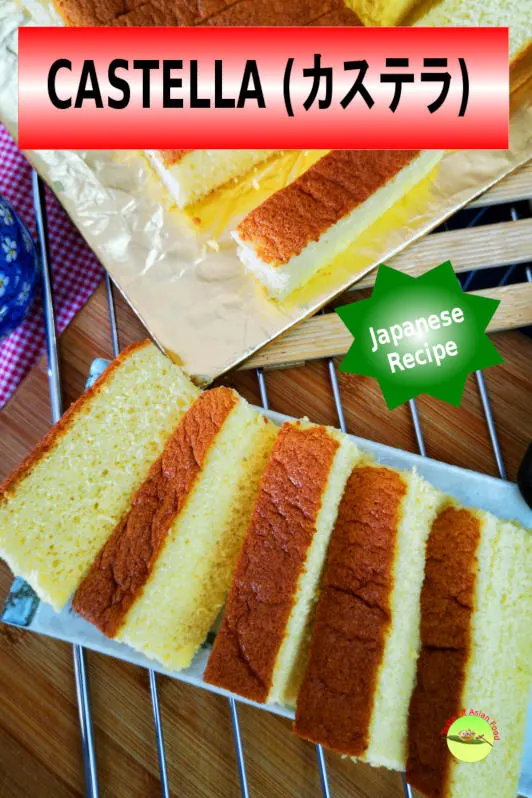
Note: This post may contain affiliate links. Please read my privacy policy for more info. I may receive commissions for purchases made through links in this post. As an Amazon Associate, I earn from qualifying purchases.
Simple castella recipe, intricate techniques
In this article, I would like to tell you about my journey to develop my castella recipe, highlighting some mistakes I made and offering solutions.
I include my recipe at the end of this article, which I think is the best. However, there are still unanswered questions that I will explore and provide an update on when I have found the answer.
For now, this stable recipe yields the best result, which took me many rounds of testing.
This post has two sections. The first section is the nitty-gritty of how I prepare the Castella. The second section is all my mistakes and the solution so that you don’t make the same mistake again like me.
The difference between the Japanese castella and the Taiwanese castella
The main difference between the Japanese and Taiwanese castella cake is the Japanese version includes bread flour in the recipe instead of cake flour or all-purpose flour, without butter and baking powder. Therefore, unlike the jiggly Taiwanese-style castella, it is springy, slightly gooey, and with a dark crust. You only need a few simple ingredients to get this attractive texture. I don’t even use vanilla extract.
How to make the Japanese castella cake
Castella has soft and tighter crumbs and is more sturdy, slightly gooey, and bouncy, thanks to bread flour. The origin formula uses Mizuame, a Japanese starch syrup made from malt and rice. I substitute it with honey as mizuame is hard to get outside Japan.
1. Make the meringue
There are two methods to deal with the eggs. You can beat the egg yolks and whites or beat them separately. Curious to know the outcome of these methods, I have made two batches of castella sponge cake and compared the results.
The castella prepared with meringue (beat separately) has a finer texture and is smoother. Although I do not know precisely why, I suspect beating the egg whites separately yields a more stable meringue.
Here are the steps:
- Separate the egg whites from the egg yolks. You can do it with your clean hands or with a yolk separator. Place the egg whites in a clean, oil-free large bowl. The bowl must be big enough to hold at least four to five times the volume of the unbeaten egg whites. Once I underestimated the volume of the meringue expanded, I ended up overflown and had to abandon the meringue.
- The bowl must be free from oil and without any trace of egg yolks, which can affect the volume of the meringue.
- Place the mixing bowl over a hot water bath to keep the egg whites warm. It is best when they reach about 40°C/100°F. The volume of the egg mixture will increase faster if the egg/sugar mixture is warm.
- Beat the egg whites with an electric mixer at low to medium speed. Low speed is better than high speed as it yields a smoother meringue, although it takes slightly longer.
- When the volume of the egg whites increases, add the castor sugar slowly.
- The egg whites and sugar will eventually gain volume and turn into a white cream. The cream (now called meringue) will become thicker with continuous whisking.
- When the meringue is about to form soft peaks, pause every twenty seconds to avoid over-whisking.
- Stop beating when the meringue forms soft peaks when you lift the beater. Under whisked meringue is unstable and will cause the cake to collapse. On the contrary, the over-whisked meringue will make the cake dense. Getting the right texture of the meringue is critical to the success of the castella cake. Therefore, I usually do not beat it until it forms stiff peaks.
2. Add the egg yolks
- Add the egg yolks to the meringue one by one. I switch off the electric mixer and mix it manually with the mixing blade of the stand mixer, but you can change it to a handheld beater. Whisk the egg yolk thoroughly until homogeneous before adding the next egg yolk. The meringue deflates if you add all the egg yolks in one go.
- It is best to whisk in one direction to minimize large bubbles and deflate the egg white.
3. Add the honey
Next, add the honey and continue mixing in one direction until homogeneous. The amount of honey required is small, just enough to let the castella have the taste without making it too sticky.
4. Add the bread flour
Sieve the bread flour. Then add half of it to the batter.
Combine the flour with the batter by mixing it gently in one direction until there are no more lumps.
Add the remaining flour and continue mixing. Try to pick up all the flour in the mixing bowl until it becomes a smooth batter without lumps.
5. Add the milk
Add the milk to the batter and mix evenly. Some Japanese recipes used sake instead.
Once it is smooth, stop mixing as over mix will deflate the batter further, causing the cake to have a dense texture.
Scrape the mixing bowl with a silicone spatula to ensure all the flour has been incorporated evenly with the batter.
Slam the bowl onto the table whenever you detect any large bubbles. Slamming helps to break the bubbles to achieve a very fine texture.
You can reduce the bubbles by forming smooth meringue with low-speed whisking and gentle mixing.
Have a few more slams to get rid of any noticeable bubbles.
6. Pour the castella batter from a high point
Line the cake pan’s base and side with baking paper or parchment paper.
Pour the cake batter into the pan slowly from the position one foot above the base. The impact of the batter onto the pan and the slow pouring action help to break the bubbles.
Fill the pan only up to sixty percent full to let the castella have enough space to rise in the oven.
Slam the cake a few more times to break any air bubbles you see. Break the smaller bubbles with the tip of a bamboo skewer or toothpick.
6. Insulate the cake pan with cardboard
Traditionally Castella is baked within a bottomless wooden frame. The cake will rise evenly when the sides are insulated.
Since I do not have a wooden frame, I wrap the corrugated cardboard with aluminum foil (to prevent the cardboard from catching fire) to form a frame that insulates the cake. You can see how it looks in the video.
Another method is to form a square cake pan (disposable) by using old newspapers. Newspapers and cardboard act as an insulator, just like wooden frames. Please watch the video in this post.
I made the cardboard frame since it is troublesome to construct the loaf pan with newspapers.
7. Bake the castella to perfection
Preheat the oven to 160°C/320°F.
Before putting the cake into the oven, ensure no large bubbles in the batter. Leave the cake pan and slam on the tables a few times to break those large bubbles. (Don’t be afraid to do this. it will not deflate the batter. ) Drawing some lines on the surface of the batter with a wooden skewer helps to break the smaller bubbles.
Place the castella on the lower rack of the oven. Bake it at oven temperature 160°C/320°F uncovered for about 50 minutes.
The baking time depends on many factors, notably the castella’s size and the heating element’s position. You need to make adjustments because every oven behaves differently.
You can increase the top temperature to 200°C/390°F in the final ten minutes if the surface has not turned to a beautiful dark brown color.
Remove the cake from the oven when the surface changes to dark brown, and the wooden skewer comes out clean after inserting it into the cake. Another way to check the doneness is to press the surface lightly with your finger. It should bounce back like a sponge.
8. Unmold the cake
Lift the cake pan and drop it a few times on the table. This method helps to minimize shrinkage. I experienced a more severe shrinkage if I did not bang it a few times after removing it from the oven. The image below shows what happened. I do not have the answer to why this step is working. If anyone knows the reason behind this, please let me know by leaving the comment below.
I got the answer! Thanks to our readers, Nikhil and Christian, for providing the answer. You can read the explanation in the comment section.
Nikhil’s answer is on September 1, 2020, and Christian’s reply is on October 28, 2020.
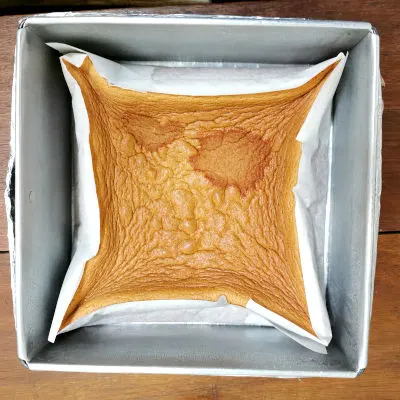
The cake will deflate a little and form some wrinkle lines after a minute. Overturn the castella on a cake board and let it be upended for a minute. This method helps to create a flat surface.
Now turn back the cake.
Use cling wrap to seal the castella while it is still warm. Place it in the refrigerator. You can also use plastic wrap but be careful not to let it touches the surface, as it will stick and ruin the surface. This storage method helps to retain moisture.
To serve, trim all the sides of the castella to make it a perfect rectangle. Cut into slices and serve.
9. Storage
You can keep the castella in the fridge for up to 5 days and freeze well up to a month.
Other related cake recipes
If you like the castella, you may also want to check out another Japanese sponge cake recipe on this blog. Castella is very eggy and without butter. For those who like more buttery cakes, our butter cake is one of the popular evergreen recipes. Do also try the marble cake for a change!
Common mistakes in making castella (and how to avoid it)
Here is a summary of all the mistakes I make before getting it right. I want to share this with you so you will not repeat the same mistakes.
Problem #1: The mixing bowl is too small.
If you use a small bowl, the volume of the meringue will swell and overflow. Since changing the bowl halfway during whisking the meringue will cause it to deflate, I have to discard it and make a new batch. It is a messy experience.
Remember, do not underestimate the volume.
Problem #2 The meringue is not smooth
You need to be patient while whisking the meringue. You can speed up by using a higher speed, which will churn out large bubbles you do not want.
The meringue will be smooth and silky if you whisk the egg whites at low speed. There will be fewer large bubbles and only form stable microfoams, which are less likely to deflate during mixing and baking.
Since the speed of my electric mixer is high, even set to the minimum, I only attach one beater to whisk the meringue.
Problem #3 The batter is not smooth
You will not get a smooth texture if the flour is not mixed well. The final appearance of the batter must be completely smooth, without any lumps. Initially, I did not get the smooth texture because I was too concerned that mixing the flour longer would deflate the batter.
Yes. Prolonged mixing will deflate the batter, but I would rather have a less spongy cake than a coarse texture, which affects the mouthfeel and appearance.
If you prepare the meringue with patience and whisk at low speed, it will not deflate much even after mixing in the flour thoroughly.
Problem #4 The batter has too many bubbles
Whisking the meringue at high speed and mixing the remaining items vigorously will create large bubbles. Avoid doing that.
You can destroy the bubbles by:
- Slam the cake pan onto the table.
- Use a wooden skewer to break the smaller one.
- Pour the batter into the cake pan from one foot above.
Problem #5 The cake collapsed at the center
Underbaked castella will collapse at the center. Another reason is the meringue is not stable, and the large bubbles break during baking.
Problem #6 The surface color is too light
If you want to get the immaculate, caramelized dark crust like those crafted by professionals at the Japanese bakery, increase the top temperature of the oven in the last five to ten minutes to darken it quickly. The color changes quite fast, so you need to keep an eye on it regularly.
I have mentioned everything I can tell you about my journey to make the castella.
Now it is your turn to bake.
Good luck!
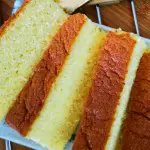
Castella Recipe - How to make (with detailed instruction)
Castella (Kasutera カステラ) catches my attention when I realize that it is a cake made with bread flour. In this article, I want to show you my journey to develop my castella recipe, highlighting some mistakes I made, and offer the solutions.
Ingredients
- 7 egg whites
- 100g castor sugar
- 7 egg yolks
- 35g honey
- 100g bread flour
- 35g milk
Instructions
- Beat the egg whites over a hot water bath with the electric mixer.
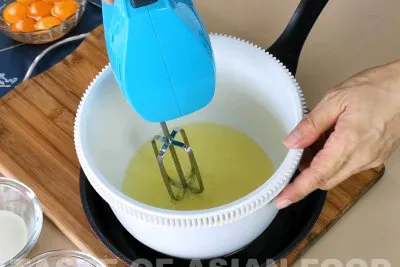
- Add the castor sugar to the egg white in batches.
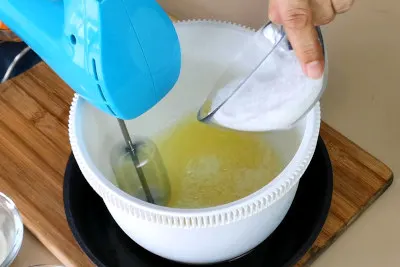
- Stop beating when the meringue forms soft peaks.
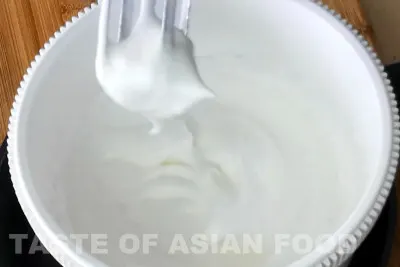
- Add the egg yolks, one by one into the meringue. Mix well.
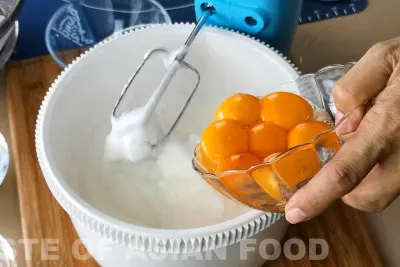
- Add the honey, mix well.
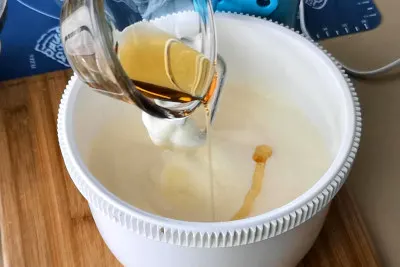
- Add the sieved bread flour to the batter in two batches. Combine thoroughly.
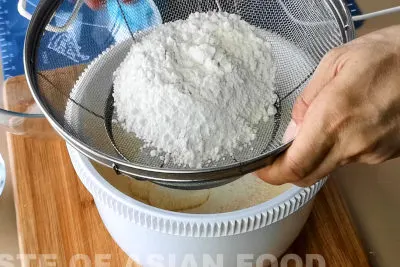
- Add the milk and mix well.
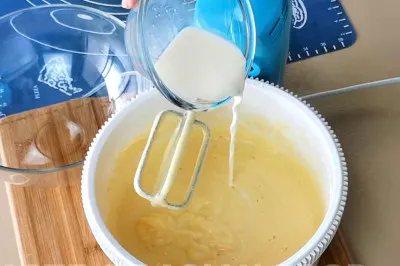
- Use the silicone spatula to scrape the side of the mixing bowl to capture all the possible flour that has mixed well.

- Prepare the cake pan lined with baking paper, and surrounded with corrugated cardboards wrapped with aluminum foil at all the sides. Pour the batter into the cake pan slowly from the position about one foot above the base. Slam the cake pan (with batter) onto the table to break the large bubbles. Use a wooden skewer to break the smaller bubbles on the surface.
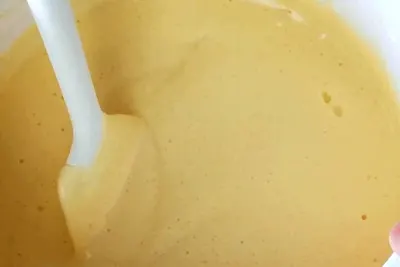
- Bake at 160°C/320°F uncovered for about 50 minutes.
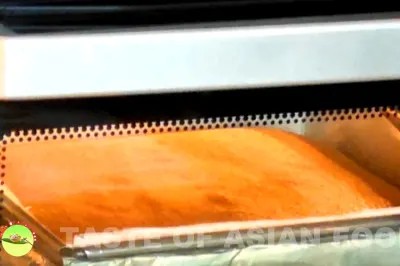
- Remove from the oven and slam it on the table to reduce shrinkage. Overturn the cake upended for one minute to flatten the surface. Wrap with cling film and leave it in the refrigerator for half a day.
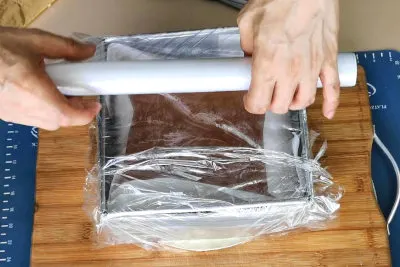
- Trim off the sides to make it a perfect rectangle. Cut it into slices and serve.
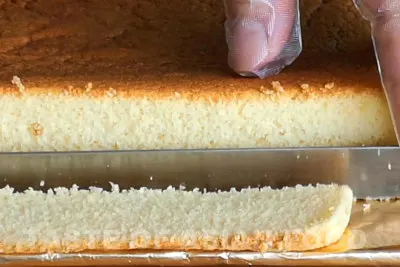
Recommended Products
As an Amazon Associate and member of other affiliate programs, I earn from qualifying purchases.
-
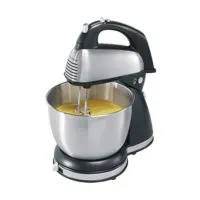 Hamilton Beach 64650 6-Speed Classic Stand Mixer, Stainless Steel, 4-Quart Bowl and Accessories
Hamilton Beach 64650 6-Speed Classic Stand Mixer, Stainless Steel, 4-Quart Bowl and Accessories -
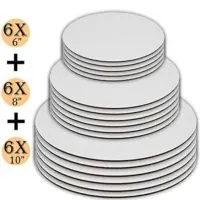 Cake Boards set of 18, Cake Boards 6 inch, Cake Boards 8 inch, and Cake Boards 10 Inch, 6 of each, Cake Board, Cake Base, Cardboard Cake Rounds, Cake Circles.
Cake Boards set of 18, Cake Boards 6 inch, Cake Boards 8 inch, and Cake Boards 10 Inch, 6 of each, Cake Board, Cake Base, Cardboard Cake Rounds, Cake Circles. -
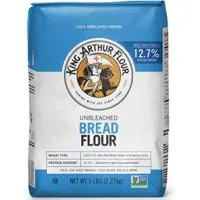 King Arthur Flour Unbleached Bread Flour, 5 Pound (Packaging May Vary)
King Arthur Flour Unbleached Bread Flour, 5 Pound (Packaging May Vary) -
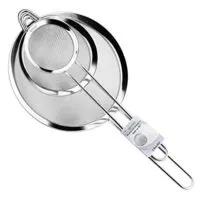 IPOW IP01115 Stainless Steel Fine Tea Mesh Strainer Colander Sieve with Handle for Kitchen Food Rice Vegetable, Set of 3
IPOW IP01115 Stainless Steel Fine Tea Mesh Strainer Colander Sieve with Handle for Kitchen Food Rice Vegetable, Set of 3
Nutrition Information:
Yield: 12 Serving Size: 1Amount Per Serving: Calories: 115Total Fat: 3gSaturated Fat: 1gTrans Fat: 0gUnsaturated Fat: 2gCholesterol: 108mgSodium: 39mgCarbohydrates: 17gFiber: 0gSugar: 11gProtein: 5g
This data was provided and calculated by Nutritionix on 5/9/2020

Castella cake 3, veel lessen. Weinig cake Eten met een Slager
Sunday 14th of December 2025
[…] Bron tasteasianfood. […]
Enjoy the Iconic Taiwan Castella Sponge Cake
Friday 7th of March 2025
[…] Castella Recipe – How to make (with detailed instruction) – https://tasteasianfood.com/castella-cake/ […]
Miro
Sunday 7th of May 2023
I followed it with a minor modification; I added the zest of a lemon to eliminate eggy flavour. It reduced it but didn't eliminate it. That said, I had no shrinkage. I don't think it had to do with the lemon. I think it's your pan. It looks like a loaf height on an 8×8. I used a regular 8x8 with parchment liner. No cardboard no water bath. When I took it out, I immediately flipped it on to a bamboo chopping board and left the baking pan on the board as a cover.
Edith
Friday 10th of December 2021
Very detailed recipe, tried and it came out perfect. Thanks for the good work. My family loved it so much.
Amanda
Saturday 17th of April 2021
wow this recipe came out perfectly for me :) I've tried and failed to make egg-white based dishes for years but this one actually came out! banging on the countertop was a great tip. There was some shrinkage after it came out, but minimal overall.
I didn't have the time to make the cardboard insulation or get one of those wooden dishes so I baked it in the water bath. The recipe reminds me somewhat of the "japanese cheesecake" or chiffon cake which often bakes in a water bath, and my theory was that it would similarly accomplish what it needed to with this recipe. Theory proven correct! you can bake the pan in a cookie sheet filled with hot water (set empty tray in oven, heat up water in microwave, pour hot water in cooke sheet, give it 5 minutes to come up to a high temp).
Jocelyn Loke
Thursday 8th of July 2021
@Amanda,
Hi, may I know by changing it to hot water bath baking, do I need to adjust the baking time and oven temperature from the original recipe? Thanks.
KP Kwan
Saturday 17th of April 2021
Thank you for trying the recipe and sharing your experience using the water bath. I hope other readers will read this and benefit from it too.